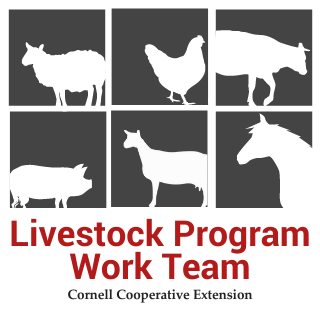My Feed Dust is Moving!? Grain Mites and How to Manage Them
By Amy Barkley, Livestock & Beginning Farm Specialist, Cornell Cooperative Extension
Every summer, I get calls from folks wondering why there are nearly microscopic bugs covering the walls and floors of their feed storage areas and their feed buckets. Looking for a cause, many easily trace it back to their bags of grain. The dust on the exterior of the affected bags appears as if it's moving in a gentle breeze, and there may be a thick layer of dust coating the inside of the feed bags. On closer inspection, it's apparent that the dust is actually hundreds of thousands of nearly microscopic grey-brown looking mites. These are grain mites.
What are grain mites?
Grain mites are very small arachnids that live in processed grains, such as cracked corn, ground wheat, and finished feed pellets, crumbs, or mash. They live in very large populations, with females laying upwards of 800 eggs over their lifetimes, or 30 eggs per day.
Why are they a problem?
Grain mites eat the most nutritious parts of the feed, such as the germ, prior to feeding on other parts of the seed and/or any mold growing on the grain. This consumption decreases the concentration and quality of nutrients in the feed for livestock, which may result in deficiencies. Additionally, they release disagreeable odors that may discourage feed consumption by animals. They are easily transmitted by insects, the wind, and people to other feed storage areas.
How did they get in the grain and what conditions do they need to survive?
The mites either transfer from a feed store, warehouse, mill, or from the environment. It's also possible for these mites to come from contaminated grains in the home pantry, such as flour or cornmeal. Grain mites are not particularly choosy about the grain they inhabit, so long as it's processed. That means that they can transfer back-and-forth between the home pantry and the feed storage area.
The shred of good news is that these mites need specific temperature and humidity ranges to flourish. They thrive in conditions with high temperatures and high humidity (55% or more). Under optimal conditions, the mites can complete their lifecycle in 9-11 days, infesting a feed storage quickly. Research indicates that their lifecycle is completed in 16 days at 71°F and 28 days at 50°F - 60°F.
How do you get rid of them?
If you find that your feed is infested, discard all feed that may have been in contact with the affected bags as well as the affected bags themselves. Alternatively, you can feed out the less infested bags, but this is not recommended because the mites quickly destroy the nutritional value of the feed. If you have a small number of feed bags and the infestation is mild, you can freeze the feed for several days to kill off the mites.
Once the infested feed has been removed, clean the area with soap and water or use an miticide as per the manufacturer's instructions. Eggs and juveniles can bear a protective coating that resists insecticides and soapy water washes. Therefore, repeated treatments may be needed to control an infestation. That all said, the best control strategy is prevention.
Cleaning and sanitizing grain bins prior to adding more feed can help reduce mite numbers. If grain is to be stored in bins or areas for more than 6 months, pre-treating the area with an arachnicide as a preventative can be helpful. The same goes for buildings where feed is stored in bags.
Check feed storage areas at two-week intervals during the warmer months and once a month during the cooler months to identify and treat early infestations. The colder winters of SWNY can act as a layer of control, so long as the grains are exposed to areas with cold temperatures and low humidities.
Another way to manage mite loads is to only purchase the amount of grain that you'll use within 2 weeks in the warm, humid months and enough that you'll use within a month during the cooler months at a time. Clean and sanitize between grain shipments for an added layer of prevention. In addition to keeping mites at bay, the shorter storage time helps to reduce natural nutrient degradation from environmental exposure over time.
These two resources were used to help compile this article:
ENTFACT-629 Grain Mites, University of Kentucky https://entomology.ca.uky.edu/ef629
Flour and Grain Mites, Penn State University https://extension.psu.edu/flour-and-grain-mites

